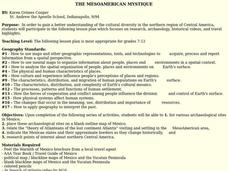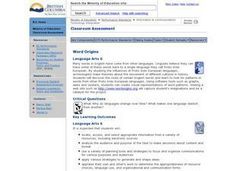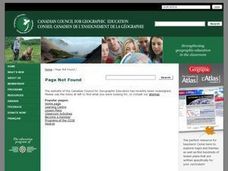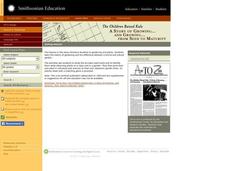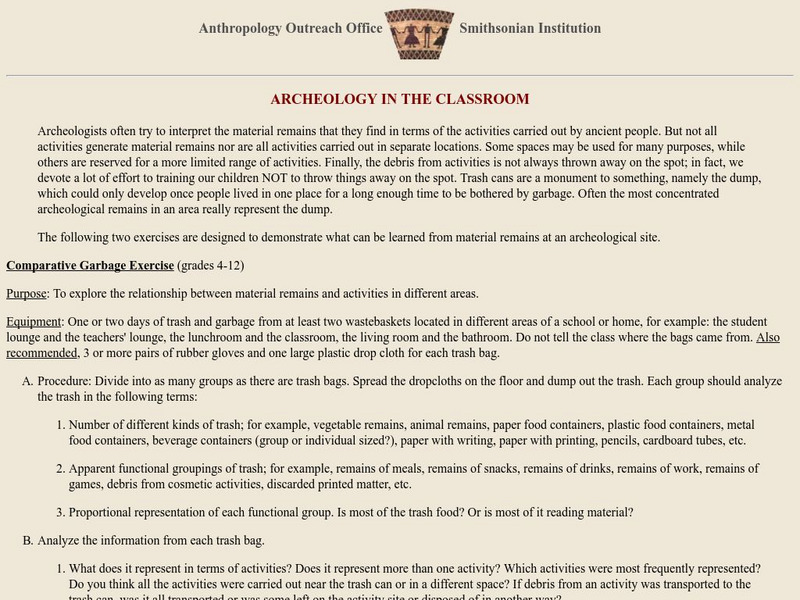Curated OER
Creating a Neighborhood Timeline
Students research information about their neighborhoods. Uncovering facts about geology and Native Americans, they examine how the neighborhood has evolved over time. They work together to create a timeline of specific events.
Curated OER
Letters from the Japanese American Internment
Students make deductions about life in an internment camp by reading and comparing letters written to Clara Breed. Along the way, they consider the advantages of looking at a historical event from the multiple points of view of...
Curated OER
It's All In The Rocks
Students think critically to determine fact or inference when examining sedimentary layers with embedded fossils. Geology and evolutionary biology are introduced. They individually write a story about various diagrams and share their...
Curated OER
Understanding Artifacts
Students will develop a greater awareness of the things surrounding them and will be able to build a bridge between their own material culture and that of an imaginary figure from the past. This instructional activity focuses on the...
Curated OER
THE MESOAMERICAN MYSTIQUE
Students research, archeology, historical videos, and travel highlights in the northern region of Central America. They identify the various archaeological / historical sites along with a date of probable existence and the title of the...
Curated OER
Language Arts- Word Origins
Sixth graders locate, access, and select appropriate information from a variety of resources, including electronic sources. They analyze the audience and purpose of the task to make decisions about content and format.
Curated OER
Teaching About Trade in the Ancient Mediterranean
Sixth graders examine the trade routes in the Mediterranean of the Ancient world. In groups, they view slides of artifacts while answering questions on a worksheet. After watching a video, they discuss how each object was found and...
Curated OER
Ancient Cyprus: The Cesnola Collection at the Semitic Museum, Harvard University
Ninth graders review what they already know about ancient civilizations. Before visiting the museum, they complete a pre-test on Cyprus and how trade is important to the island. During the visit, they travel in small groups to examine...
Curated OER
Rock Art and Ritual
Students explore, examine and determine what kinds of rock art motifs are likely the product of ancient ritual descent. They identify connections between rock art symbolism and Native American ritual practices. Each student also views a...
Curated OER
Why is the Past Important?
Young scholars explore, examine and study why it's important to study the past and connect this importance with reasons why we should learn from the past and how cultures have changed over the years. They bring an object, photograph or a...
Curated OER
House Keys: The Architectural Features of Victorian Homes and Buildings
Students analyze Victorian architectural patterns wit regard to materials, doorways, windows, towers, bays, roofs, and decoration. Students discern varying architectural traits by studying Victorian era pictures and drawings and using a...
Curated OER
Baga Drum
Learners examine a Baga Drum in order to explore the history of the Baga people of West Africa. In this art history lesson, students recognize figures used in Baga Drum design that represent aspects of Baga culture. They also design and...
Curated OER
Study Guide for the 2009 Doris Conant Lecturer on Women and Culture: Barbara Ehrenreich
Students analyze the teachings of Barbara Ehrenreich about women and culture. In this women and culture instructional activity, students define "joy" and "collective joy." Students do field research on these topics and write a field...
Smithsonian Institution
Smithsonian Learning Lab: Decoding the Past: The Work of Archaeologists
Through this study, learners will think like an archaeologist, and move towards a better understanding of our world by taking a look back at civilizations of the past.
Other
Division of Archaeology: Activity Guides
Find lesson plans for elementary and middle school students that include archaelogy activities for sites primarily in Louisiana. Take a look at the life of Archaic period Mound Builders, and find many examples of artifacts.
Smithsonian Institution
National Museum of Natural History: Relative Dating in Archaeology [Pdf]
Activities for the classroom that teach about stratigraphy and seriation, two methods used in the relative dating of objects in archaeology.
National Endowment for the Humanities
Neh: Edsit Ement: Traces: Historic Archaeology
Excellent lesson plans that challenge students to consider every day uses for artifacts. Site provides an analysis worksheet that will help students consider the importance of artifacts in understanding historical people. Links to sites...
Louisiana Department of Education
Louisiana Doe: Louisiana Believes: English Language Arts: Grade 6: If Stones Could Speak
Sixth graders will explore history and will learn that archaeologists, like detectives, work to piece together the past through investigation. Archaeological research provides us with stories of human history that help us understand the...
Lin and Don Donn
Lin and Don Donn: Archaeology Lessons
This site provides three suggestions for lessons to teach about archeology.
PBS
Pbs Teachers: Scientific American: Science Safari: The First People
Emulate the work of archaeologists in South Africa attempting to solve the riddles of human evolution by inferring a person's height from the length of one bone. Identify and communicate present-day rituals through ancient art techniques.
Smithsonian Institution
National Museum of Natural History: Archeology in the Classroom
Two different leveled lessons allow students to become archeologists as they interpret material remains left behind by ancient people.
Utah Education Network
Uen: Nhmu: Cultural Clutter Tales in the Trash
Fourth graders list three or more types of evidence of prehistoric cultures that encouraged archaeologists to investigate the marshes around the Great Salt Lake.
PBS
Pbs Teachers: Scientific American: Science Safari: City of Gold
Investigate the challenges facing archeologists when dealing with local cultures near dig sites, and consider the difficulty of remaining sensitive to the past yet still being able to learn from it.
PBS
Pbs Teachers: Scientific American: Dead Men's Tales: Undisturbed Find
Emulate the work of archeologists by creating and excavating an archeological find. Record the exact location and position of every dig artifact to maintain the coherency of the find.
Other popular searches
- Archaeology Math
- Archaeology Videos
- Art and Archaeology
- Science Archaeology
- Archaeology Recording Form
- Archaeology Internet
- Archaeology Animal
- Material Culture Archaeology
- Olympic Archaeology
- Music and Archaeology
- Archaeology of the Future
- Archaeology Alaska






